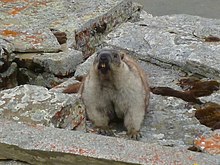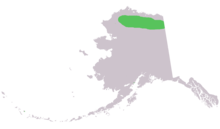Alaska marmot
| Alaska marmot | |
|---|---|

| |
| Scientific classification | |
| Domain: | Eukaryota |
| Kingdom: | Animalia |
| Phylum: | Chordata |
| Class: | Mammalia |
| Order: | Rodentia |
| Family: | Sciuridae |
| Genus: | Marmota |
| Species: | M. broweri
|
| Binomial name | |
| Marmota broweri | |

| |
| Range of Marmota broweri in Alaska. Its range also extends slightly into Canada. | |
The Alaska marmot (Marmota broweri), also known as the Brooks Range marmot
Taxonomy
Originally Marmota broweri was perceived as a synonym for M. caligata,[5][6] but this was soon proven false when evidence was found that corroborated M. broweri as a unique species.[7][8][9] Cytochrome b sequences were used to verify M. broweri as a distinct species.[9] Studies are still needed to evaluate the effects of genetic isolation on their fragmented distribution.[10]
Evolution
The Alaska marmot's ancestry traces to the
The evolutionary lineages of the 14 marmot species distributed across the
Distribution and habitat
Distribution
In terms of global distribution, the Alaska marmot is
Alaska marmots are found scattered throughout Alaska as small colonies, each consisting of several families.[16] Their locations have been documented in the Brooks Range from Lake Peters to Cape Lisburne and Cape Sabine.[17] There have been sightings of the species near rivers in the Northern Baird mountains, in the Mulik Hills,[18] near Copter Peak in the De Long Mountains,[19] and south of the Brooks Range in the Spooky Valley and in the Kokrines Hills.[11]
Habitat
The Alaska marmots are found in grassland, inland cliffs, and mountain peaks. They are located at elevations of about 1,000 metres (3,300 ft) to 1,200 metres (3,900 ft).
Description
Alaskan marmots possess a short neck, broad and short head, small ears, short powerful legs and feet, bushy and densely furred tail, and a thick body covered in coarse hair.[20] Adult Alaska marmots’ fur on their nose and the dorsal part of their head are usually of a dark color.[22] Their feet may be light or dark in color.[20] M. broweri have tough claws adapted for digging,[20] however the thumbs of their front limbs do not have these claws but flat nails instead.[22] Their body size is highly variable due to hibernation cycles.[23] For males, the average total length is 61 centimetres (24 in) and the average weight is 3.6 kilograms (7.9 lb).[3] Adult females are slightly smaller, having an average length of 58 centimetres (23 in) and 3.2 kilograms (7.1 lb).[3]
Anatomical distinctions
The
Compared to the very similar hoary marmot, also found in Alaska, M. broweri are much softer. They also lack the characteristic white facial patch of hoary marmots. The groundhog, another Alaskan marmot, can be told apart by its more reddish coloring, as compared to the grayer Alaskan and hoary marmots.[20]
Ecology
Diet
The Alaska marmot's main nutrition source is vegetation that grows on mountain sides, which includes
Predation
The Alaska marmot is preyed on by
A sentry marmot will alert the colony via a two-toned, high-pitched warning call if there is a predator in the area.[20] The older marmots will defend and keep a lookout for predators while the young play. Dens dug solely in dirt provide limited protection, but a den built under rocks and boulders can prevent the risk from large animals, such as grizzly bears, who dig marmots out of their dirt-dug dens.[22]
Ecosystem impact
Marmots enrich soil with uneaten food, nesting material, and their feces, and help to aerate the soil with their digging. They also serve as a food source for a variety of predators.[20]
Behavior
Social behavior
Alaska marmots are very social, living in colonies of up to 50 while all sharing a common burrow system.[4] Marmots typically have their own personal den, while the young live with their mother and the father lives in a nearby den. Especially in large colonies, the Alaska marmots utilize sentry duty rolls that are periodically rotated.[22]
M. broweri will mark their territory by secreting a substance from face-glands and rubbing the sides of their face on rocks around their den and various trails.[9] Alaska marmots also enjoy sunbathing and spending a large amount of time in personal grooming.[4]
Hibernation
M. broweri is one of the longer hibernating marmots, being documented to do so up to eight months annually.[4] Alaska marmots accumulate a thick fat layer by late summer to sustain them throughout the winter hibernation.[20] Alaska marmots are active until snow begins to fall, when they will go to their hibernacula from around September until June.[3] Alaska marmots have special winter dens with a single entrance that is plugged with a mixture of dirt, vegetation, and feces during the winter hibernation period.[20] These winter dens are built on exposed ridges that thaw earlier than other areas, and the entire colony stays within the den from September until the plug melts in early May.[20] They then settle in their dens in family units to communally hibernate for the winter.[23]
Communal hibernation may be an adapted strategy to reduce metabolic cost while trying to keep their body temperatures above freezing.[23] During hibernation many of their body functions decrease such as body temperature (averages between 4.5 °C (40.1 °F) and 7.5 °C (45.5 °F)), heart rates, and respiratory rates.[22][23] Alaska marmot hibernation is not continuous because they will awaken every three or four weeks in order to urinate and defecate.[4][23] Inside the hibernaculum den, the Alaska marmot has shown long-term hibernation adaptions by their ability to tolerate high CO2 levels and low O2 levels.[24] As an adaption to the Arctic environment and permanently frozen ground, Alaska marmots breed prior to emerging from the winter den.[20] The Alaska marmots will generally emerge from the den during the first two weeks of May.
Reproduction
Male Alaska marmots are
Conservation status
The status of Alaska marmots is not well known due to the difficulties in finding them in their natural habitat.
Dangers
Although dangers of direct human disturbance are minimal, climate dangers pose a significant threat. The Alaska marmot is arguably the most sensitive of the 14 marmot species to anthropogenic disturbances, including climate change.[4]
Captive rearing
M. broweri has been reported to have been successfully reared in captivity and reintroduced into the wild, but there have been cases where captive rearing led to high rates of mortality.[4]
Relationship with humans
Marmota broweri are sometimes hunted by
Marmot Day is a relatively new Alaskan holiday with parallels to Groundhog Day.[26][27] Sarah Palin signed a bill in 2009 to officially make every February 2 Marmot Day.[26] The bill, introduced by Senator Linda Menard, said, "It made sense for the marmot to become Alaska's version of Punxsutawney Phil, the Pennsylvania groundhog famed for his winter weather forecasts."[26] She did not expect marmots to have any weather-forecasting duties but rather hoped that the state would create educational activities regarding the marmot.[26]
References
- ^ . Retrieved 11 November 2021.
- ^ "Marmota broweri". NatureServe Explorer. Retrieved 17 April 2024.
- ^ a b c d e f "North American Mammals: Marmota Broweri". Smithsonian Institution National Museum of Natural History. Archived from the original on 4 December 2011. Retrieved 7 October 2011.
- ^ a b c d e f g h i j k l m n o p Hubbart, Jason A. (2011). "Current Understanding of the Alaska marmot (Marmota broweri): A Sensitive Species in a Changing Environment". Journal of Biology & Life Sciences. 2 (2): 6–13. Archived from the original on 2012-04-26. Retrieved 28 November 2011.
- ISSN 0008-3550.
- ^ Hall, E.R. (1981). The mammals of North America. New York: Wiley-Inter science.
- S2CID 22442599.
- ^ Hoffmann, R. S.; J.W. Koeppl; C.F. Nadler (1979). "The relationships of the amphiberingian marmots (Mammalia: Sciuridae)". University of Kansas Museum of Natural History, Occasional Paper. 83: 1–56.
- ^ from the original on 13 December 2013. Retrieved 25 November 2011.
- ^ a b c d "Alaska Marmot (Marmota broweri)". Alaska Department of Fish and Game. Archived from the original on 28 December 2021. Retrieved 29 January 2022.
- ^ ISBN 978-1-60223-047-7.
- .
- ^ from the original on 20 March 2022. Retrieved 28 November 2011.
- S2CID 51772006.
- ^ Youngman, P. M. (1975). "Mammals of the Yukon Territory". National Museums of Canada, Ottawa, Publications in Zoology. 10: 1–192.
- ^ Hoffmann, R. S. (1999). D. E. Wilson; S. Ruff (eds.). "Alaska Marmot, Marmota broweri". The Smithsonian Book of North American Mammals: 393–395.
- ^ Childs, H. E. (1969). "Birds and mammals of the Pitmegea River region". Cape Sabine, Northwestern Alaska, Biological Papers of the University of Alaska: No. 10.
- hdl:11122/1492.
- ^ Macdonald, S. O.; J. A. Cook (2002). "Mammal inventory of Alaska's National Parks and Preserves". Northwest Network: Bering Land Bridge National Preserve, Cape Krusenstern National Monument, Kobuk Valley National Park, Noatak National Preserve, National Park Service Alaska Region, Inventory and Monitoring Program Annual Report 2001.
- ^ a b c d e f g h i j k l m n o p Curby, Catherine. "Marmot.Wildlife Notebook Series(On-line)" (PDF). Alaskan Department of Fish & Game. Archived (PDF) from the original on 13 August 2013. Retrieved 2 December 2011.
- ^ Bee, J. W.; E.R. Hall (1956). "Mammals of northern Alaska on the Arctic slope". University of Kansas Museum of Natural History Miscellaneous Publications. 8: 1–309.
- ^ a b c d e f g h i j k Rasmussen, J. "Marmota Broweri (On-line)". Animal Diversity Web. Archived from the original on 13 December 2013. Retrieved 25 November 2011.
- ^ S2CID 85045056.
- from the original on 2022-03-20. Retrieved 2018-12-24.
- ^ "CPI Inflation Calculator". bls.gov. Archived from the original on 5 July 2018. Retrieved 2 March 2022.
- ^ a b c d "Marmot Day: Alaska Adopts Its Own Version Of Groundhog Day". Green News. The Huffington Post. 1 February 2010. Archived from the original on 20 March 2022. Retrieved 27 November 2011.
- ^ The Associated Press. "Alaska to celebrate its first Marmot Day", Archived 2010-02-05 at the Wayback Machine Fairbanks Daily News-Miner. Feb. 1, 2010. Accessed Feb. 1, 2010.
External links
 Media related to Marmota broweri at Wikimedia Commons
Media related to Marmota broweri at Wikimedia Commons


